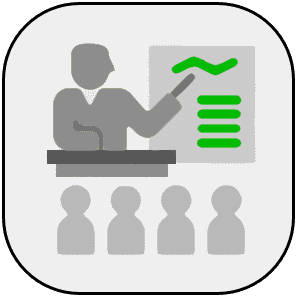What is Strategy Dynamics?
The Strategy Dynamics method from Kim Warren is a technique that can be
used to explain the business performance to date, and develop strategies for
improving the future performance, based on building and retention of resources
and capabilities.

The target of Strategy Dynamics is to answer some challenging questions
(figure):
- Why is the business performance following its current path?
- Where will the business performance go if we continue the way we are
doing today?
- How can we design a robust strategy to radically improve the performance
into the future?
The ultimate concern of strategic management is to quantitatively improve
performance through time. Whether for the enterprise as a whole, or for a
key function of interest [e.g. sales]. This trajectory depends, strongly and
unavoidably, on what has occurred over the organization's history, and will
continue to do so. The method therefore starts from a time-chart of the organization's
performance over its relevant history, and the future period of interest,
as measured by one or more conventional indicators [e.g. revenue or profits].
Rather than seek statistical explanations for this performance, the method
drills back along the logical causal chain. Revenue = sales volume x price.
Costs = salaries + sales & marketing + R&D. Etcetera. Each element is mapped
on a diagram, whether on paper, white-board or software. Any non-constant
item is, like the performance outcome itself, depicted with a time-chart of
its values over the past, and as estimated into the future.
After 2-3 steps, this drill-back process reaches one or more 'resources' [strictly,
accumulating asset-stocks]. These resources are factors whose behavior is
such that they fill up, and drain away over time. Customers, cash, people,
products in a product range, and capacity are the most common examples. The
logical causality rule still applies. Sales volume = customers x sales-per-customer
. Total salaries = staff x average salary.
The next element of the method is critical - the current value of such asset-inventories
is not 'determined by' any other factor, but is mathematically identical to
the sum of all element that were ever added, minus all elements that were
ever lost. This is fundamental in the case of cash. Cash-today is equal to
all cash that was ever received, minus all cash that was ever spent. But this
is equally true of every other asset-inventory. Today's customers is equal
to every customer that was ever won, minus every customer that was ever lost.
Today's staff is equal to every person that was ever hired, minus every person
that was ever lost. Today's product range is equal to every product that was
ever launched, minus every item that was ever discontinued. This is why today's
performance and future performance are both unavoidably dependent on history.
The next question of causality is to explain what has been driving these 'flow-rates'.
How quickly customers have been won, or how quickly staff was lost. These
flow-rates turn out to be dependent upon:
- Management Decisions [e.g. the amount of money spent on marketing is
influencing the customer acquisition. The salaries that were offered are
influencing the staff attrition.
- External Factors [e.g. other firms' marketing or salaries, or customers'
disposable income], and crucially also upon
- Existing Resource-levels [ e.g. customer loss rates depend on service
quality, which depends on adequate staff numbers]. All of this is populated
with quantitative time-path information.
The three Principles of Strategy Dynamics are:
- Performance depends on resources.
- Resources fill and drain.
- These flow-rates depend on existing resources.
When combined, the principles create an integrated strategic architecture
that depicts the 'physics' of the system - highly analogous to the flow-charts
found in chemical process plants or power-transmission systems - and how this
system determines performance through time.
Once this core architecture of an enterprise is complete [or of a business
segment], additional factors can be added by extending the same principles.
Key amongst these is the role of potential resources [e.g. likely customers]
and the various development-states of resources [e.g. junior, middle, senior
staff, or products in research, development and launched]. The impact of intangible
factors can be captured. How does reputation affects customer acquisition.
How does the morale influences staff turnover. Competitive rivalry effects
can be estimated, e.g. likely rates at which rivals may win a newly-developing
customer segment. And the impact of organizational capabilities can be evaluated.
Origin of Strategy Dynamics. History
The underlying science is the
System Dynamics method,
originated by Prof Jay Forrester at MIT in the 1960s, applied explicitly to
a resource-perspective of organizations and strategy and the principle of
asset-stock accumulation highlighted by Dierickx and Cool, and long recognized
to lie at the heart of Strategy and performance. However, in contrast to the
Resource Based View
[Wernerfelt, Barney, Grant, et al], and competence-based and knowledge-based
perspectives on strategy, the method stresses the importance of mundane resources
[products, people, capacity ...] as well as the role of rare and inimitable
factors believed to be responsible for sustained competitive advantage. The
method also differs from 'Systems Thinking' approaches [Senge et al] in emphasizing
resource-accumulation and the importance of quantifying change-through-time,
in contrast to the qualitative, feedback orientation of that tradition.
Calculation of Strategy Dynamics. Formula
Performance(t) = f[Resources(1-n, t), Decisions(t), Exogenous factors(t)]
Resource(i,t) = Resource(i,t-1) +/- Resource-flows(i,t-1 to t)
Resource-flows(i,t-1 to t) = f[Resources(1-n, t), Decisions(t), Exogenous
factors(t)]
Usage of the Strategy Dynamics method. Applications
- The method is applicable to every kind of enterprise, whether commercial,
public-service, or voluntary, as well as to every function within an enterprise.
- It is also applicable to not yet existing enterprises, such as new ventures
or voluntary initiatives.
Steps in Strategy Dynamics. Process
- Quantify the time path of the current performance objective, and of
the anticipated or desired performance objective.
- Identify and quantify over time the causal relationships back to the
resources that directly drive performance.
- Quantify the flow-rates of these resources over time.
- Trace the causality from these resource flow-rates back to the decisions,
exogenous factors and existing resources on which they depend.
- Connect these dependencies to create the core "strategic architecture"
for the enterprise.
- Optional: Extend this core architecture to encompass potential resources,
resource-development, intangible factors, rivalry etc.
Strengths of Strategy Dynamics. Benefits
- The method is strongly evidence-based and rigorous, and it provides
a good understanding of the causes of current performance, and it provides
confidence in the future performance.
- Since it highlights exactly where management actions and decisions exert
control, it provides clear and specific strategies and action plans, that
are adaptable when the future unfolds.
- The method is evidence-based, and it can solve differences of opinion
amongst team-members. Also it allows each individual [both amongst the management
team and below] to see where their activity contributes to the whole, and
on whom they depend.
- The method provides a solid foundation for methods as the
Balanced Scorecard [Kaplan
and Norton] and for Value
Based Management, and is a means of integrating other established strategy
frameworks and approaches, such as
PEST, Core Competence,
Value Chain.
Limitations of Strategy Dynamics. Disadvantages
- The method is demanding, and time-consuming, but not excessively so,
given the value at stake from improved strategies and decisions.
- There are significant limits to the certainty that can be applied to
certain factors, e.g. measures for reputation or capability, and to some
important causal relationships, e.g. to what extent reputation influences
the rates of customer acquisition.
Assumptions of the Strategy Dynamics approach. Conditions
- To maximize its impact, the method requires extensive factual evidence,
including history, about many aspects of the enterprise and its performance.
Frequently, these key numbers are unknown, in which case the team must be
prepared to exercise its judgment in estimating what those missing values
might be, and what impact they may have.
- The approach depends on management's willingness and ability to be quantitative
in their decision-making, which not all cultures find easy.
Book: Kim Warren
- Competitive Strategy Dynamics
Book: Kim Warren
- The Critical Path
Book: Lars Finskud
- Competing for Choice
|
Forum discussions about Strategy Dynamics.
|
🔥
|
Pathdependency of Performance
Strategy Dynamics deserves some more recognition and should be an integral part of strategic planning. It can show why similar companies, applying the same strategy will end up with different results....
 1 |

|
Learning Experience... Well Done..
A professional collection of inputs enhancing a real time learning experience for graduate students... Well done, a comprehensive digest of strategic thinking and planning......
 1 |
|
|
|
Courses about Strategy Dynamics.

Beginners Course
|

Advanced Course
|

Course for Experts
|
|
|
|
The best, top-rated topics about Strategy Dynamics. Here you will find the most valuable ideas and practical suggestions.
|
|
|
Advanced insights about Strategy Dynamics. Here you will find professional advices by experts.

Consultancy Tips
|

Teaching Tips
|

Practical Implementation Tips
|
|
|

|
Strategy Dynamics in SMEs How to Reach the Top
What distinguish best performers from meteors - companies performing well only in a short run - is the capability to exc...
|
|
|
|
Various sources of information regarding Strategy Dynamics. Here you will find powerpoints, videos, news, etc. to use in your own lectures and workshops.
|
|
|
Useful tools regarding Strategy Dynamics.

News
|

Videos
|

Presentations
|
| |

Books
|

Academic
|

More
|
|
|
|
Compare with Strategy Dynamics:
Business Simulation
| System Dynamics
| Resource Based
View | Balanced Scorecard
| Value Based Management
| Value Chain |
Value Stream Mapping
| Benchmarking
Return to Management Hub: Decision-making & Valuation | Knowledge & Intangibles | Strategy & Innovation
More Management Methods, Models and Theory
|
|
|














